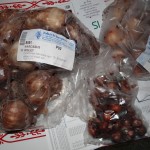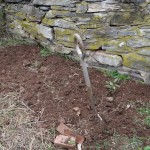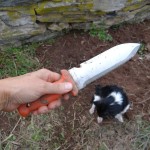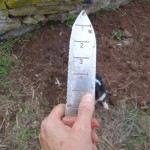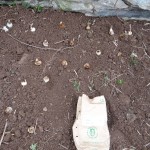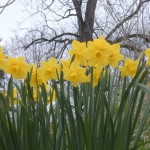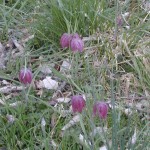Every year I order some sort of flower bulbs for fall planting. It gives me something to look forward to in spring before the garden soil is ready to work; bulbs in bloom really help to lift late winter blahs. There are a couple bulb purveyors with whom I’ve done more than a decade’s worth of business and I have never had any complaints: Brent and Becky’s Bulbs in Virginia and Van Engelen/John Scheepers in Connecticut. (John Scheepers is good for smaller quantity orders.) Fall 2013 will be the year for planting Narcissus miniatures; I’ve selected multiple species that don’t grow over 12 inches high.
With very few exceptions, most bulbs like full to partial sun. Bulbs that prefer part-shade are Leucojum and Oxalis. Only Erythronium likes shade. You can plant bulbs under deciduous trees and shrubs. The bulbs will grow foliage and flower before being shaded by a shrub’s emergent leaves, so it’s a great combination.Bulbs prefer neutral soil that drains–no wet feet. For soils that hold moisture, bulbs like Leucojum, Fritillaria meleagris or Camassia will work.
Break up the planting area’s soils deeply below the bulb planting depth and amend it using well-aged compost, peat or Maryland products like Leafgro. You can add grit to help drainage if necessary. In the past, I would buy bone meal at planting time, but being surrounded by woodlands and pastures, bone meal attracts critters to the planting area. Instead, my preference is for something like Espoma Bulb Tone which comes in 4 or 20lb bags. A 4 pound bag can get mixed into 60 square feet of planting bed soil or you can broadcast it on top. The literature recommends fertilizing again when the bulb foliage is 6 inches high and bulb companies also say to fertilize after flowering to “grow the bulbs/offsets”.
Generally bulbs go in the ground when the soil temps have dropped to at least 55 degrees but before the ground freezes. They do better with up to 4 inches of topsoil above them, to protect from frost heaving as soil thaws and refreezes over and over in the winter season. Too little soil on top means roots won’t develop properly. Plus, covering with about 2 inches of loose leafy mulch with help over the winter.
Most bulbs will have a pointy side and root remnants so you can tell stem from root end. A few of the very small bulbs are hard to determine which end is up, but can right themselves after planting, like Anemones and Corydalis. Bulbs which are planted most deeply will be heavy and large sized: those tall Alliums like Globemaster and Crown Imperial Frittilaria go 7-8 inches deep! Asiatic lilies, taller growing Narcissus and all but the species Tulips go somewhere between 6-8 inches deep. The smallest bulbs go 4 inches deep and the rest, no more than 5-6 inches below ground level. My favorite all around tool to use for this is my soil knife from A.M. Leonard which digs, cuts through fibrous root mats, loosens soil and gravel and has depth markings on it. I use it almost every time I’m in the garden and it has a belt holster.
I like to naturalize bulbs in some area–choose hardy types for zone 6 or lower that aren’t fussy and will multiply by bulblets or seed. If you are plagued by rodent pests, you’ll probably want to choose species that aren’t high on the squirrel or vole menu. Just a few naturlizer examples are Narcissus, Crocus, Alliums, Chionodoxa, Galathus and Hyacinthoides. You can use a scatter effect with tossing the bulbs on the ground randomly or plant in larger or smaller drifts by color or type. White Flower Farm says” plant in ovals, wider in the center, tapering at the ends. If planting in grassy areas, make certain you can tolerate not mowing until the foliage dies down…
My planting will start against a protected stone wall, since a number of my species Narcissus are relatively rare and I’m starting with fewer per package. I also want to group all my Narcissus miniatures together in case I want to identify them for a flower show in the future. This area was dug over once and planted with a mix of seeds called “Grandma’s Garden” about 7 years ago. Since then, the most vigorous plant, Tickseed, has out-competed almost everything else. I have to weed out lots of vines, roots and unwanted weeds before I can expand and plant this entire bed. I’ve got some smaller viburnum shrubs planted near this wall and the bulbs will grow around those too. It’s an area I am finally revitalizing. I’m down to just the Narcissus triandrus cultivars to plant, but have discovered that the neighbor’s guinea hens think my loosened soil there is great for making dust bath pits. Now I have to think of a barrier to lay over the top of my planted areas!
At the end of October, Carroll Garden Club will once again be planting large naturalizing Narcissus along our roadways. Look for the newest planting area off Rt. 140 near Baughers!
- The Big Box O’ Bulbs
- Partial list of my order
- Three different sizes of miniature Narcissus species
- An portion of the area I am reclaiming from weeds and thugs
- A.M. Leonard–soil knife gets daily use
- Useful markings on the soil knife
- Bulb layout in the stone wall bed
- Larger daffodils planted two years ago
- Fritillaria meleagris naturalizing under ash tree



